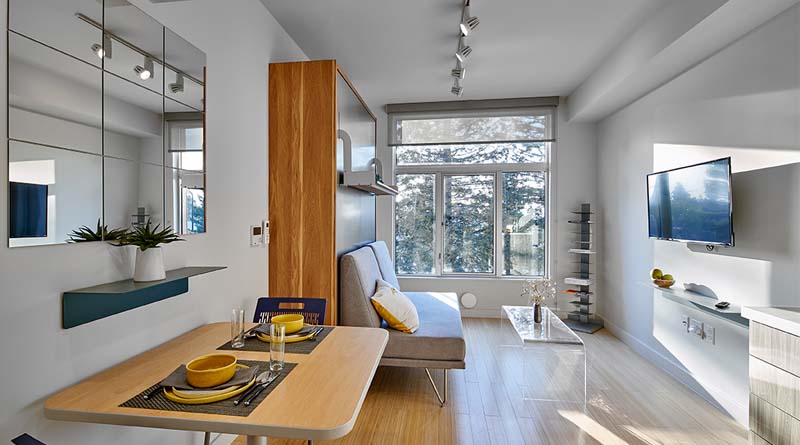By Nick Gomez
As school administrators evaluate solutions that allow for the safe return of students in coming months, modular design and construction presents great opportunities for both short- and long-term considerations.
In higher education, we’ve seen success utilizing a modular approach for student housing, particularly in land sparse urban environments where there’s a need to support greater density. Paradoxically, this solution also responds to today’s circumstances and the unique challenges presented by COVID-19. By adopting a decentralized housing model, universities can provide smaller, community-based options to students which support social distancing and limit exposure.
For example, two of Lowney Architecture’s modular student housing projects, 2711 Shattuck in Berkeley, Calif., and the award-winning 38 SmartSpace Harriet in San Francisco, feature approximately 20 self-contained microunits each, including many of the same amenities as a small studio apartment, like private kitchens and restrooms. By replicating this smaller-scale approach to housing, students and their families can find peace of mind knowing there’s lower risk for contamination or building shutdown than with the high-rise tower residences typically found in urban centers.
In addition, by easing construction costs and shortening project timelines, a modular approach can allow for greater incorporation of advanced building mechanical systems such as improved HVAC filtration, contactless technology, and easier to sanitize anti-microbial fixtures and finishes. These benefits span beyond building functionality and performance and become a marketable tool for recruiting.
While K-12 districts are not traditionally tasked with providing housing for students, modular construction can be similarly explored in areas where workforce housing is being considered to attract needed faculty and staff or to meet the need to expand other school facilities.
Temporary, semi-permanent and permanent modular structures are all good options for school districts to explore when things don’t go as planned. As quick, affordable solutions, modular buildings can help solve a number of problems ranging from a sudden need to expand physical space due to a pandemic, changes in funding and unexpected fluctuations in population or enrollment.
In terms of providing healthy learning spaces, modular structures can also be designed to incorporate elements like ample ventilation, natural light, and mold-resistant drywall. In states like California — where the Division of the State Architect (DSA) provides design and construction oversight for K-12 schools, community colleges, and various other state-owned and leased facilities — a variety of modular solutions for schools have already been reviewed and approved. These range from temporary facilities like standalone portable classrooms to more permanent extensions of entire academic buildings. Modular construction has proven to be a viable solution in these applications as it can easily comply with both DSA regulations and state design standards for classroom layout.
Modular is also appropriate for all climates, with adjustable insulation, cladding and heating and cooling systems. When approaching the building’s envelope, special considerations can be made to ensure ample resistance to air, water, heat, light, and noise.
Compared to traditional, site-built construction, modular can be just as flexible and versatile. It can be adapted to meet the changing needs of a district and support a variety of teaching styles, learning needs, and seating configurations. By incorporating elements like folding doors, modular structures can even facilitate experiential learning by blurring the lines between indoor and outdoor teaching space.
When you consider the design of most traditional schools in response to the social distancing needs and other challenges of this pandemic, it’s clear that there is an urgent need to develop strategies for building occupancy. Single corridors, enclosed stairwells, restroom facilities and limited points of entry all create pinch points where maintaining a six-foot clearance would be extremely challenging, even at 50% capacity. Modular structures that incorporate varying building and mechanical systems could be leveraged to quickly and affordably mitigate this need, creating additional space not just for classrooms, but also for restrooms, kitchens, limited dining space, faculty and staff lounges, or even utility closets.
It’s worth noting that due to both factory construction limitations and highway transportation regulations when shipping modules to the site, modular is not always a viable solution for large, open spaces such as gymnasiums, auditoriums, or cafeterias.
For districts where new land might not be readily available or affordable, modular structures can still be explored if there are ways to repurpose existing outdoor space. Consider the need, use, timeline, and expected duration. Are these structures intended to be temporary facilities, or more permanent expansions? Hard surfaces like parking lots or K-8 recreational areas work well for housing these structures and would be more beneficial in the long run than sacrificing a sports field, for example.
Considerations should also be made to accommodate any operational or staffing changes that can support the addition of new modular facilities, including how they will meet security requirements, work within existing site circulation, and integrate with the campus’ visual identity.
Nick Gomez has over 15 years of experience working on multi-family housing and modular projects for both nonprofit and for-profit clients. As Director of Lowney Architecture’s Multi-family Studio, Nick has managed award-winning projects from design development through construction administration.


